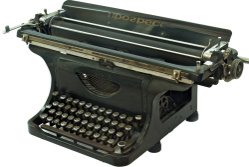Blog posts tagged shortcuts
IT for Donuts: six PowerPoint shortcuts that’ll make you a presenting pro
 IT for Donuts is our regular weekly feature where we explain a tech term or answer a question about business IT.
IT for Donuts is our regular weekly feature where we explain a tech term or answer a question about business IT.
This week, we reveal six simple PowerPoint shortcuts that can make your presentations super-slick. If you want to become a presenting pro, read on
Useful PowerPoint shortcuts
All these shortcuts will work when you’re actually giving a presentation with PowerPoint, rather than when you’re editing your presentation.
Try them out before you use them in anger, to make sure you’re comfortable and happy with how they work.
During your presentation:
- Press B on your keyboard to temporarily show a blank, black slide.
- Press W to temporarily show a blank, white slide.
- Press CTRL + P to turn the mouse pointer into a pen, so you can draw directly on your slide.
- Press CTRL + E to turn the mouse pointer into an eraser, so you can erase what you’ve drawn.
- Press CTRL + A to turn the mouse pointer into an arrow, so you can point things out on the slide.
- If your slide includes video or audio, press ALT + P to play or pause it.
TOTW: Essential Windows 8 keyboard shortcuts
Decided to take the plunge and upgrade to Windows 8? Here are a few new keyboard shortcuts that might improve your workflow.
(Personally, I'm still trying to remember some of the Windows 98 key combinations...)
|
Windows + I |
|
|
Windows + X |
|
|
Windows + Number key |
|
|
Windows + Ctrl + Shift + Number key |
|
|
Windows + C |
|
|
Ctrl + Shift + Esc |
|
|
Windows |
|
|
Windows + D |
|
|
Windows + B |
|
|
Windows + M |
|
|
Windows + Q |
|
|
Windows + W |
|
|
Windows + E |
|
|
Windows + R |
|
|
Windows + T |
|
|
Windows + U |
|
|
Windows + P |
|
|
Windows + + |
|
|
Windows + F |
|
|
Windows + H |
|
|
Windows + K |
|
|
Windows + < |
|
|
Windows + L |
|
(via MSDN Blogs)
Friday Donut tip: faster ways to select text in Microsoft Word
 Every Friday afternoon we bring you a great business IT tip. From nuggets that make repetitive tasks easier to simple ways to banish business tech annoyances, we’re here to help.
Every Friday afternoon we bring you a great business IT tip. From nuggets that make repetitive tasks easier to simple ways to banish business tech annoyances, we’re here to help.
If there’s something you’d like our help with, send an email to [email protected] or just leave a comment on this post. We’ll try and cover it in a future IT Donut tip.
Working with text in Microsoft Word
If you’re anything like me, you probably use Microsoft Word a lot. If so, you can make it much easier to edit and move text around simply by learning a few shortcuts that help you select text.
Once you get the hang of these (it won’t take long), you’ll be surprised at what a difference it makes to your work:
- To select a single word, just double-click that word with your mouse.
- To select a whole paragraph, simply triple-click a word with the mouse.
To select a single line of your document, move the mouse pointer into the left margin of your document. It should change to point to the right. Then click once.
Bonus tip:If you want to extend the size of a selection you’ve already made, it’s easy to do so using your keyboard. Hold down the shift key, then tap the right arrow to increase the amount of selected text, one letter at a time. To extend the selection a whole word at a time, hold CRTL and shift and tap the right arrow. |
Other Friday Donut tips:
Friday Donut tip: useful keyboard shortcuts
 Every Friday afternoon we bring you a great business IT tip. From nuggets that make repetitive tasks easier to simple ways to banish business tech annoyances, we’re here to help.
Every Friday afternoon we bring you a great business IT tip. From nuggets that make repetitive tasks easier to simple ways to banish business tech annoyances, we’re here to help.
If there’s something you’d like our help with, send an email to [email protected] or just leave a comment on this post. We’ll try and cover it in a future IT Donut tip.
Be more efficient with useful keyboard shortcuts
The layout of a standard keyboard is a hangover from the days of typewriters. As the story goes, the keys are ordered in a way designed to reduce typing speed, to stop old-fashioned typewriters jamming so often.
But even if the keyboard you use every day is an anachronism, knowing some useful keyboard shortcuts can make you much more efficient.
Keyboard shortcuts let you perform tasks by pressing particular combinations of keys, instead of moving the mouse to click buttons or select from menus. It doesn’t take long for them to become second nature, so here are our most useful keyboard shortcuts.
These all work in recent versions of Microsoft Windows. However, Mac and Linux users will find many keyboard shortcuts are identical or similar. Remember, when we say ‘CTRL+C’, it means you should hold down the CTRL key and tap C on your keyboard.
Useful shortcuts when working with text
These useful keyboard shortcuts will have you copying, pasting and moving text with ease.
- CTRL+C copies whatever text is selected on to your computer’s virtual clipboard
- CTRL+X cuts text from the screen and moves it to your clipboard
- CTRL+V pastes the text on the clipboard into your document
- CTRL+A selects all the text in a window
- CTRL+Z undoes whatever you just did. Often you can step back through recent edits
- CTRL+Y redoes your edits. Use with CTRL+Z to move back and forth through changes
- CTRL+P will print your document
- CTRL+B turns selected text bold
- CTRL+I makes selected text italic
- CTRL+U underlines selected text
Most of these shortcuts will work in other situations too. For instance, if you’re editing an image you can cut out a portion using CTRL+X.
Useful shortcuts when navigating Windows
These useful keyboard shortcuts are designed to help when working with files, folders and your desktop. The Windows key is the one with the little Microsoft Windows flag on it.
- WINDOWS+D minimises every window on your screen, so you can see your desktop
- WINDOWS+L locks your desktop – great if you’re popping away from your PC
- WINDOWS+E opens a new Explorer window so you can navigate to files
- WINDOWS+TAB lets you jump between open applications. Keep tapping tab to find what you want, then release both keys to jump to that program.
- If you have a file selected on your screen, just hit F2 to rename it
Which useful keyboard shortcuts do you use most? Leave a comment to let us know.



